Презентація: "The Norman Conquest"
Спецкурс з Літератури Великої Британії для учнів 10-11 класів
Тема: Old English period. Medieval literature
THE NORMAN
Bayeux Tapestry Xl century
* Bayeux Tapestry
r06eneH 1,13 6ahé (KOBép "3 6avhé) — naM9THVIK cpeAHeBewgoro MCKYCCTBa, npeacTagnmou-wu,3 C060Vl BblUJVIBKY no nbHAHOMY nonoTHY UJVIPMHOVI 0Kono 60 CM VI AJUIHOVI CBblUJe 100 M. V1306paxaeT CUeHbl nourOTOBKV1 HOPMaHACKOro 3aBoegaH',1A Al-qrru,1M VI 6MTBbl npv•l racThHrce 1066 r.; C03AaH B KOH.XI— 8B.. B npe3eHTaL4L,lM mcnonb3Y}0Tcg CUeHbl "3 r06eneHa.
CONQUEST
As you already know, four different peoples invaded England.
First came the Celts in the 6th century BC; then the Romans in the 1st century BC; they were followed by the Anglo-Saxons in the 5th century AD; after them came the Danes at the end of 8th century.
In the 11th century England was invaded by Normans.
This was the fifth and the last invasion of England.
THE NORMANS
In the 9th century while the Danes were plundering England another branch of Northmen who were related to the Danes were doing the same along the Northern coast of France. They came to be called the Normans, a variation of the word "Northmen". The Danes, as you already know, settled down in the conquered part of England known as the Danelaw. Likewise, the Normans settled down on land conquered from the French king — a territory which is still called Normandy after these Normans.

 Many changes came about in the life of the Normans and the Danes after the 9th century. By the 11th century the Danes finally settled down as subjects of the English kings. At time went on they gradually mixed with the Anglo-Saxons among whom they lived. Thus they retained their Germanic language and many of their customs that were very much like those of the Anglo-Saxons.
Many changes came about in the life of the Normans and the Danes after the 9th century. By the 11th century the Danes finally settled down as subjects of the English kings. At time went on they gradually mixed with the Anglo-Saxons among whom they lived. Thus they retained their Germanic language and many of their customs that were very much like those of the Anglo-Saxons.
But the Normans who had settled down in France were now quite different from their Germanic forefathers. They lived among the French people, who were a different people, with different manners, customs and language. They had learned to speak the French language, and, in many ways, they had become like the French themselves. They adopted their manners, customs, and way of life.
They adopted their manners and customs, and their way of life. Although the Normans lived under the rule of their own duke. By the 11th century the dukes of Normandy had become very powerful. Though they acknowledged the king of France as their overlord, they were actually as strong as the king himself.
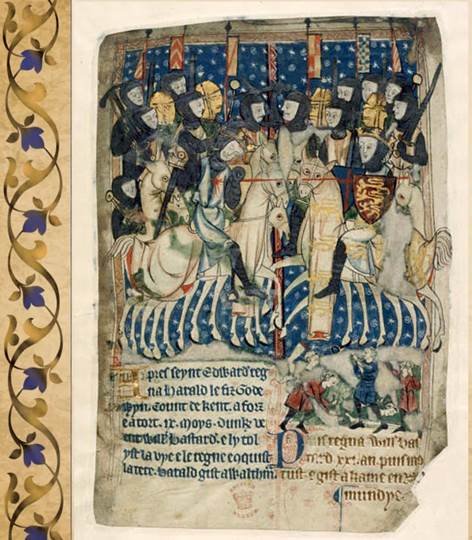 The descendants of the Northmen who had settled in northern France in the 9th century became the new conquerors of England. In 1066 William, the Duke of Normandy, began to gather an army to invade Britain. The pretext for the invasion was William's claims to the English throne. He was related to the king who died in 1066. According to the English law it was the Witenagemot that chose the next king; if the late king left a son he was sure to be chosen; if not, the King's Council of wise men would offer the Crown to some other near relative of the dead king.
The descendants of the Northmen who had settled in northern France in the 9th century became the new conquerors of England. In 1066 William, the Duke of Normandy, began to gather an army to invade Britain. The pretext for the invasion was William's claims to the English throne. He was related to the king who died in 1066. According to the English law it was the Witenagemot that chose the next king; if the late king left a son he was sure to be chosen; if not, the King's Council of wise men would offer the Crown to some other near relative of the dead king.
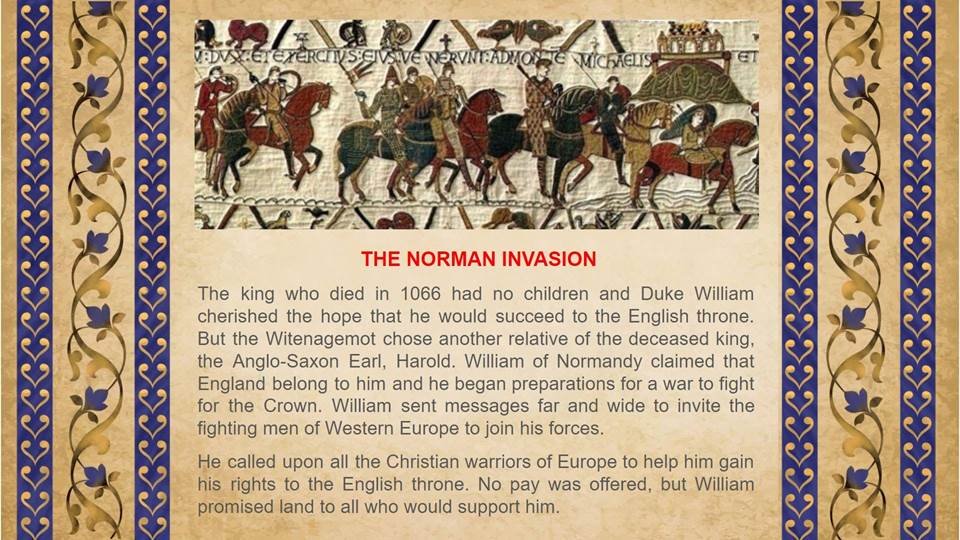
William also ask the Roman Pope for his support. He promised to strengthen the Pope's power over the English Church. And the Church with the Roman Pope at the head blessed his campaign and called it a holy war.
![]() There were many fighting men who were ready to join William's army since it was understood that English lands would be given to the victors. William mustered a numerous army which consisted not only of the Norman barons and knights but of the knights from other parts of France.
There were many fighting men who were ready to join William's army since it was understood that English lands would be given to the victors. William mustered a numerous army which consisted not only of the Norman barons and knights but of the knights from other parts of France.

Many big sailing-boats were built to carry the army across the Channel. William landed in the south of England and the battle between the Normans and the Anglo-Saxons took place on the 14th of October 1066 at a little village in the neighbourhood of the town now called Hastings. The Normans outnumbered the Anglo-Saxon forced and were greatly superior in quality. They were all men for whom fighting was the main occupation in life. They were well armed and the chance of being killed was not so great, since they all wore armour.
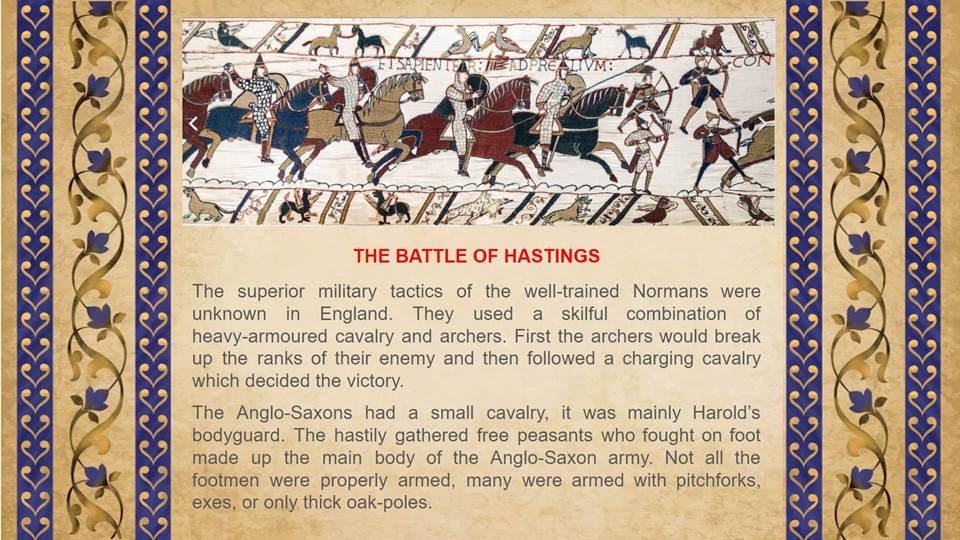
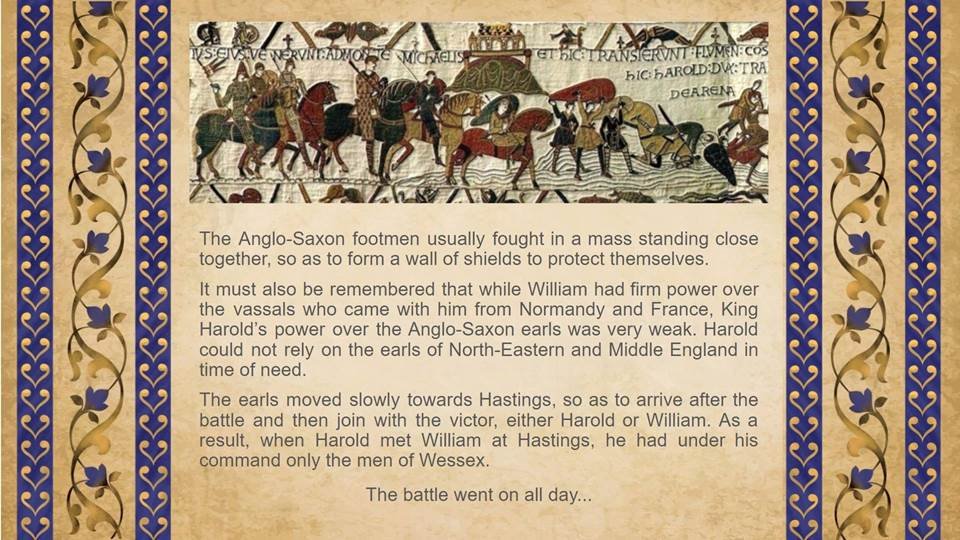
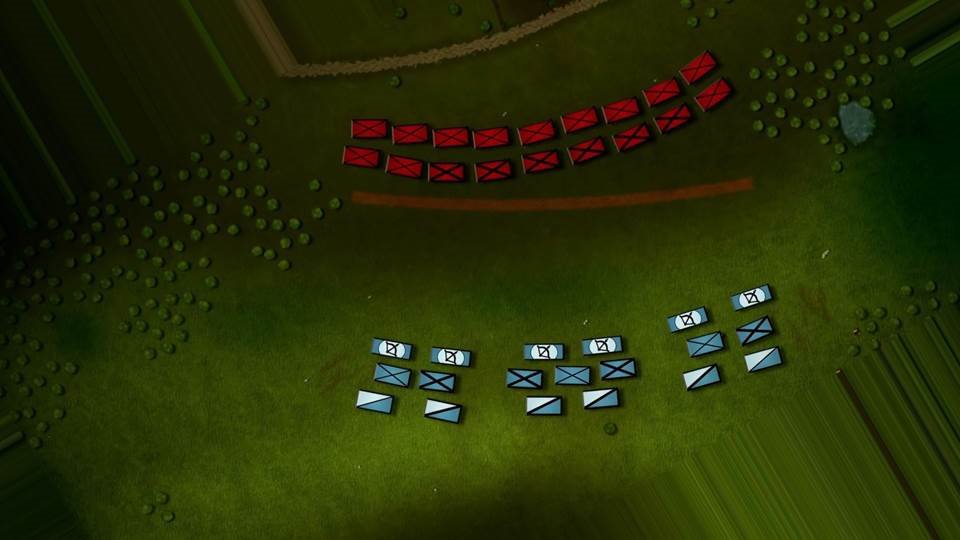
The victory at Hastings was only the
beginning of the Conquest. It took several years for William and his barons to subdue the whole of England. Soon after the victory at Hastings the Normans encircled London and the Witenagemot had to acknowledge William as the lawful king of England. Thus the Norman duke became king of England — William I or, as he was generally known, William the Conqueror. He ruled England for 21 years (1066—1087). During the first five years of his reign the Normans had to put severely down many rebellions in different parts of the country. The largest rebellions took place in 1069 and 1071 in the North-East. Whole villages were ruined — every cottage was burnt to the ground, people were killed, cattle were driven off, all the crops and orchards were destroyed.
![]()
![]()
![]()
![]()
![]()
![]() In 1071 the subjugation of the country was completed.
In 1071 the subjugation of the country was completed.
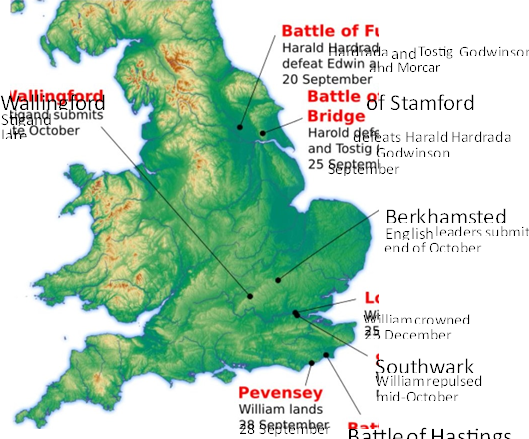 Battle of Fulford
Battle of Fulford
London
William defeats Harold 14 October Location of major events during the Norman Conquest in 1066
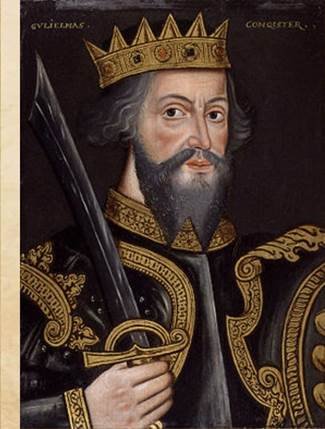 First of all, William the Conqueror made himself independent of his overlord, the king of France. He also declared that all the lands of England belonged to him by the right of conquest. One-seventh of the country was made the royal domain. The other lands the king granted to the Normans and Frenchmen who had taken part in the Conquest and to the Anglo-Saxon landlords who had supported him.
First of all, William the Conqueror made himself independent of his overlord, the king of France. He also declared that all the lands of England belonged to him by the right of conquest. One-seventh of the country was made the royal domain. The other lands the king granted to the Normans and Frenchmen who had taken part in the Conquest and to the Anglo-Saxon landlords who had supported him.
![]() William I replaced the Witenagemot by a Great Council, made up of bishops and barons. Their tasks were to meet and talk over governmental problems and to give their advice to the king. Also, the Great Council was to act as the king's Supreme Court and it presided over all serious trials. The king's laws were in force everywhere, Nobles were not allowed yo make war on one another; all men had to keep "the king's peace".
William I replaced the Witenagemot by a Great Council, made up of bishops and barons. Their tasks were to meet and talk over governmental problems and to give their advice to the king. Also, the Great Council was to act as the king's Supreme Court and it presided over all serious trials. The king's laws were in force everywhere, Nobles were not allowed yo make war on one another; all men had to keep "the king's peace".
William I organised the first registration of England. All the king's vassals were registered in the Domesday Book and William I could now see to it that they all performed their military service and all their estates with their value. Thus the feudal registration of 1086
WILLIAM THE CONQUEROR consolidated the position of the conquerors.
1027—1087
EFFECTS ON THE LANGUAGE
The Anglo-Saxon Chronicle says:
..ln 1086 William the Conqueror sent his men all over England, into every shire to find out what property every inhabitant of all Englandpossessed in land, or in cattle and how much money this was worth <...> and then all these writings were brought to him. .
William swore that he would govern the Anglo-Saxons as well as any king before him had done in this country, if they were faithful to him.
"... The King William was severe beyond all measure to those people who resisted his will. The earls who resisted him were kept in chains. He deprived bishops of
![]() The victorious Normans made up the new aristocracy and the Anglo-Saxon people became their servants. The Norman aristocracy spoke a Norman dialect of French, a tongue of Latin origin, while the Anglo-Saxons spoke English, a tongue of Germanic origin. Thus there were two different languages spoken in the country at the same time: the Norman-French became the official language of the state. The peasants and townspeople spoke English.
The victorious Normans made up the new aristocracy and the Anglo-Saxon people became their servants. The Norman aristocracy spoke a Norman dialect of French, a tongue of Latin origin, while the Anglo-Saxons spoke English, a tongue of Germanic origin. Thus there were two different languages spoken in the country at the same time: the Norman-French became the official language of the state. The peasants and townspeople spoke English.
As a result of the Conquest, the English language changed greatly under the influence of the French language. The two languages gradually formed one rich English language
their power and lands, and abbots oftheir abbacies, and cast earls into prison. <...> There is no doubt that people were greatly oppressed in his time. .
which already in the 14th century was being used both in speech and writing. Gradually the Normans mixed with the Anglo-Saxons and the Danes and from this mixture the English nature finally emerged.
The Norman Conquest brought about very important changes in the life of the Anglo-Saxons.

 We have seen what little power King Harold had over the great lords. The Anglo-Saxons earls did not even join their king at Hastings. After the Conquest the royal power in England strengthened greatly.
We have seen what little power King Harold had over the great lords. The Anglo-Saxons earls did not even join their king at Hastings. After the Conquest the royal power in England strengthened greatly.
The conquerors turned into serfs many Anglo-Saxons peasants who had been free before.
They brought with them their language, laws and customs.
Under their rule the English language changed greatly.
The Norman Conquest
Questions for discussion:
1 . What was there in common between the Danish and Normans raids on the countries of Western Europe in the 9th century? In what ways did the life of the Danes and Normans differ in the 11th century?
2. What was the reasons and the pretext for the Norman invasion?
3. What facts prove that the Norman army was greatly superior to the Anglo-Saxon army?
4. Describe the way the Anglo-Saxons army was drawn up in the battle of Hastings. What were the advantages and disadvantages of their positions?
5. Explain the battle-plans of both armies. Prove that the Anglo-Saxons fought fiercely for their independence.
6. What were the reasons for the defeat of the Anglo-Saxons at Hastings?
7. In what years did the rebellions against the Norman conquerors take place? Why did the largest rebellions take place in the North-East of england?
8. What is the Bayeux Tapestry? Why is it considered a valuable historical document? What can we learn from a study of its pictures?
9. Prove that the William the Conqueror became the greatest feudal lord in England.


про публікацію авторської розробки
Додати розробку
